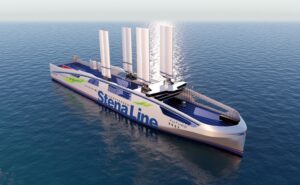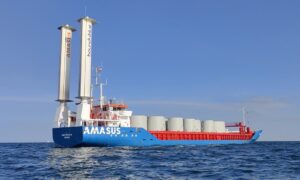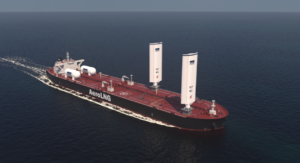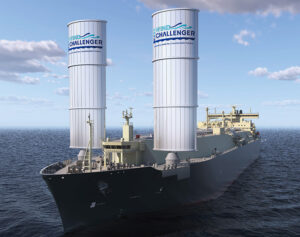ICS: Wind-assisted propulsion, air lubrication improve efficiency and reduce URN
A new study by the University of Southampton, commissioned by the International Chamber of Shipping, has revealed the synergies between the implementation of energy efficiency measures, such as wind-assisted propulsion and air lubrication technology, and the reduction of underwater radiated noise (URN).
A new study by the University of Southampton has been launched to assess the interrelationship between measures aimed at enhancing ship energy efficiency and underwater radiated noise emissions.
Underwater radiated noise is the unintentional noise generated by vessels as they move through the water. The propulsion system of ships represents a significant URN source, especially at frequencies below 200 Hz.
Studies have found that URN generated by shipping can impede marine life, particularly marine mammals, both in the short- and long term. In recognition of this issue, the International Maritime Organization (IMO) issued guidelines in 2014 that have now been revised following the Marine Environment Protection Committee (MEPC 80) in July this year.
Related Article
-
IMO’s revised GHG strategy adopted, ‘by or around 2050’ net-zero target for shipping
Authorities & Government
The new study reviews the IMO’s initiatives and strategies for decarbonizing the shipping industry and identifies the measures and tools available that can contribute to expediting the transition.
By adopting certain energy efficiency strategies that also reduce underwater radiated noise, shipowners and the environment can co-benefit.
Effectively mitigating noise propagation from commercial vessels entails the implementation of several important measures. The new study recognizes the opportunity to reverse the upward trends in URN, simply by leveraging synergies of URN with energy efficiency measures. These measures include optimization of propellers, encompassing factors like diameter, blade number, blade area, pitch, skew, rake, and blade sectional shape. This can yield substantial reductions in URN emitted by ships, according to ICS.
Furthermore, alternative propulsion types and air lubrication systems are recognized as energy efficiency measures that can work in synergy with URN.
READ MORE
- LNG keeps its crown: Alternative fuel orders show LNG still holding strong
- Are air lubrication systems both sustainable and profitable?
- Wind-propulsion installations poised to surpass 50 mark in early 2024
The alternative propulsion system is categorized into wind-assisted propulsion systems and fuel cell, battery, and hybrid systems.
Wind-assisted propulsion systems have already been deployed on 28 large vessels as of 2023, according to classification society DNV. Their adoption is projected to increase substantially in the coming decade. This technology harnesses aerodynamic forces to reduce a vessel’s propulsion requirements, resulting in potential energy efficiency enhancements ranging from 5% to 9% for specific ship types, with claims of achieving up to 25%. Furthermore, they can significantly reduce URN by more than 10 dB, the study reveals.
Meanwhile, air lubrication systems enhance energy efficiency by reducing the hydrodynamic resistance between a ship’s hull and seawater. This is achieved through the injection of air along the flat bottom area of the vessel.
Remarkably, this technology holds the potential to deliver substantial energy efficiency improvements, ranging from 5% to 15%, while concurrently achieving a remarkable reduction in URN of over 10 dB, according to ICS’ study.
“The ICS commissioned report shows that shipping has an opportunity to embrace energy efficiency technologies that will both help ensure it meets its essential greenhouse gas emission reduction targets as well as reducing underwater radiated noise. Overall, the report should help in choices being made for future ship design and operation that reduce the overall environmental impact of shipping,” Professor of Maritime Fluid Dynamics Stephen Turnock, University of Southampton’s Marine and Maritime Institute (SMMI), said.
“At ICS we welcome this report. It recognises that most energy efficiency measures will also reduce URN, and therefore presents a win-win situation for shipowners. For safe and cost-effective operation, it is important that shipowners retain discretion on the selection of measures,” Chris Waddington, Technical Director of the International Chamber of Shipping, commented.
“But for example, modest speed reduction, such as we have seen as a consequence of the EEXI regulation can improve both efficiency and reduce URN for vessels fitted with fixed pitch propellers. Similarly, both wind-assisted propulsion and air lubrication improve efficiency and can each provide around 10 dB URN reduction.”
“There is no one size fits all solution for the challenge we have ahead but we recognise that by improving energy efficiency, URN can also be reduced and our oceans can be healthier,” Waddington concluded.








